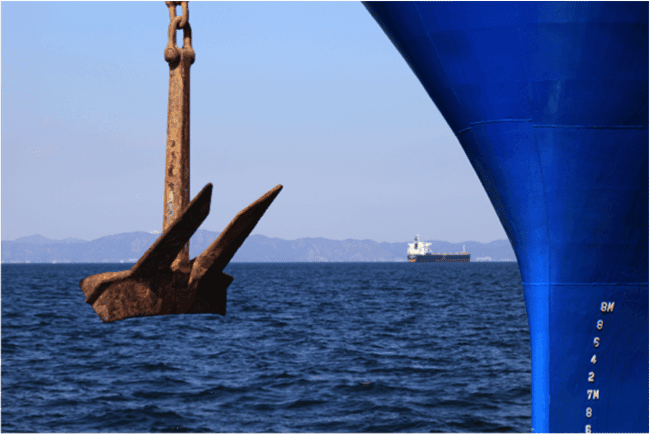A tanker in ballast dropped anchor and six shackles of chain in the early evening to await a berth for loading. Winds were force 4, but stronger winds were forecast so the main engines were kept on standby.
Early the next morning, with winds now gusting to force 6-7, the OOW deduced that they were dragging anchor as the vessel had departed its swing circle. The anchor party mustered on the foredeck, but by the time they had done so, the vessel had already reached a speed of about 2.8 knots.
Once at the anchor station, the personnel realized that the vessel was not dragging anchor, but that the anchor had been lost. The main engine was engaged and the vessel was able to safely make its way out of the anchorage.

Lessons learned
- Anchors and associated gear are for holding ships in light to moderate weather conditions. For more adverse weather, drifting or slow steaming (hove-to) would be the safer option.
- Vessels in ballast are particularly vulnerable to wind effects. This should be considered when anchoring.
Reference: nautinst.org
Our Company has initiated an Anchor Awareness Campaign as lost anchors are the root causes of many groundings and collisions and the crew and officers need to be aware of the risks and assess them thoroughly, especially in heavy weather.
A growing number of anchor losses reported in recent years prompted DNV GL, Gard and The Swedish Club to investigate this issue further. Based on an analysis of cases involving anchor and anchor chain losses, the project partners have issued a video and a presentation identifying the most frequent technical and operational causes, and steps crews and operators can take to address them.
Most anchor losses are preventable if proper maintenance and handling procedures are followed. One of the key findings of this investigation is the importance of the officers and crew being aware of the environmental loads their equipment is designed for. Lack of awareness of the classification societies’ limitations imposed when the anchoring equipment was approved was a frequent cause. If these limits are not taken into account during shipboard anchoring operations, there can be significant damage to the vessel – even beyond the loss of anchor and chain. In almost half of the cases, we saw that environmental risk factors, such as weather, strength of the currents and water depth, played a significant role in the loss. Another common cause was the crew’s lack of expertise and training in the handling of anchoring equipment, including maintenance of the utmost important windlass breaks and the securing of the anchors and chains.
There were also a number of instances where technical or equipment failures, such as heavily worn brake band linings; corrosion of chain links; spile pins of D-shackles falling out as not being correctly secured; problems of chain stoppers and tensioning devices etc., were among the causes.
The relevant Campaign material are uploaded onboard all managed vessels by our IT in a folder named “2Q20 - Anchor awareness campaign”. It contains relevant P&I articles, Classification advise on the matter, relevant informative videos and a case study. Please study these material carefully and arrange a relevant training/presentation in June. We have also opened a relevant training operation in Benefit (sub: Vision Zero Campaign: Anchor Awareness) for July for all vessels to post the revevant training reports.
